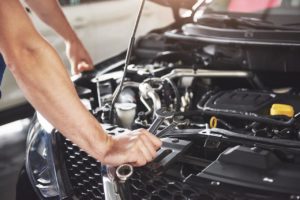Replacing a Fuel Line
 Fuel lines can deteriorate with age and are subject to fail over time and this means that they need to be repaired or replaced. It doesn’t matter whether they are rubber or steel, there are two types of fuel lines. There’s the one that connects the fuel tank to the pump and then there is the one that connects the pump to the fuel system on the engine. The one connecting the pump to the tank is on the suction / vacuum side of the pump while the one that goes from the pump to the fuel system handles pressure. And on fuel injected vehicles the pressure can be in the neighborhood of 45 to 60-PSI, while carbureted vehicles typically use only 4 to 8-PSI. To make the connections there is a wide range of connectors, some requiring special tools. However, many applications use steel tubing and these use flare fittings to connect them at their terminal ends. The absolute best repair is to replace the entire steel line however, when this isn’t possible, use fuel injection rated hose because rubber hose will eventually seep fuel.
Fuel lines can deteriorate with age and are subject to fail over time and this means that they need to be repaired or replaced. It doesn’t matter whether they are rubber or steel, there are two types of fuel lines. There’s the one that connects the fuel tank to the pump and then there is the one that connects the pump to the fuel system on the engine. The one connecting the pump to the tank is on the suction / vacuum side of the pump while the one that goes from the pump to the fuel system handles pressure. And on fuel injected vehicles the pressure can be in the neighborhood of 45 to 60-PSI, while carbureted vehicles typically use only 4 to 8-PSI. To make the connections there is a wide range of connectors, some requiring special tools. However, many applications use steel tubing and these use flare fittings to connect them at their terminal ends. The absolute best repair is to replace the entire steel line however, when this isn’t possible, use fuel injection rated hose because rubber hose will eventually seep fuel.
You can use gear clamps, spring clamps or specialized fuel line clams to make a secure, leak proof connection. These are made by several brands such as: Glarks, Ticonn, Lockman, and Tech Team. Tech Team offers a full range of size specific clamps so that you don’t have to buy a whole assortment just to get a few clamps in the right size. https://techteamproducts.com/product-category/clamps/ They offer mini gear clamps https://www.amazon.com/dp/B08KH9JL5S?ref=myi_title_dp spring clamps https://www.amazon.com/dp/B08V5MX7KD?ref=myi_title_dp , and spring tension fuel line clamps https://www.amazon.com/dp/B08V5KQH58?ref=myi_title_dp . In addition, they have a great video that shows you how to measure so that you buy the correct clamp size.
Now in order to repair a leaky steel fuel line you need to follow some steps, pay attention to the safety precautions.
- Keep all flames and sparks away, far away when making the repair
- Locate some type of drain pan or catch basin so that it can catch anything that drips.
- Using a tubing cutter, cut the steel fuel line on both sides of the damage, measure the gap, and, using the piece you just cut out, go buy some synthetic rubber tubing that will make a tight fit over it.
- Cut a piece of the rubber tube that is 2-4 inches longer than the gap.
- Use steel wool to clean and polish both ends of the steel tube for 2-3 inches.
- Place your clamps over the ends of the tubing and slide the tube over the ends of the steel tubing, make sure they go on all the way. For best results use 2 clamps at each end. You can use a little oil to lubricate and make the process easier.
- Now tighten the clamps and you are all set.
